Trending
Opinion: How will Project 2025 impact game developers?
The Heritage Foundation's manifesto for the possible next administration could do great harm to many, including large portions of the game development community.

Featured Blog | This community-written post highlights the best of what the game industry has to offer. Read more like it on the Game Developer Blogs or learn how to Submit Your Own Blog Post
Looking into how game genre classification evolved on early Nintendo consoles in the 80's and 90's.

Here's a selection of the genre selections from some of the leading game platforms:
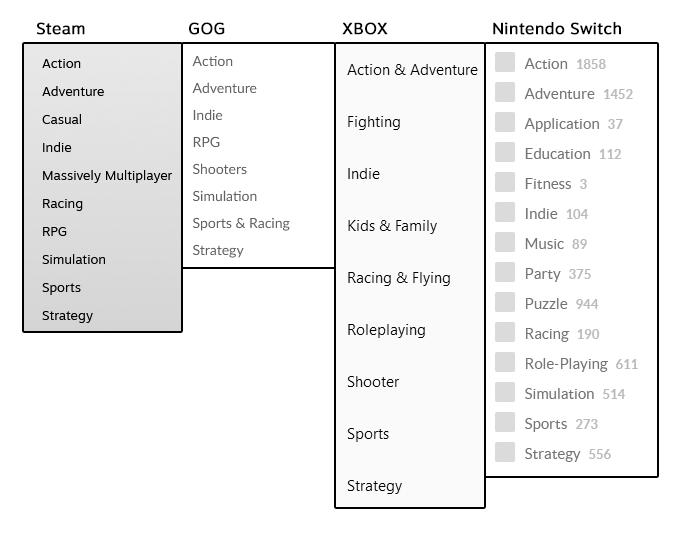
Playstation is excluded because I couldn't find a browse by genre view for the web version of the PSN store
All platforms have the following genres in common:
Action
Adventure
Indie
Racing
RPG / Roleplaying
Simulation
Sports
Strategy
Aside from "Indie" which arose fairly recently, these "classic" genres have been around as far as I can remember. Why did we wind up with these particular genres? How has their meaning changed over time? How far back do their origins go?
To answer this question definitively would be a major undertaking, so in this particular article I'm just going to travel briefly back in time to the late 80's and early 90's, looking only at Nintendo (specifically Nintendo of America). If this article proves interesting I might do some other eras and platforms (starting with SEGA).
What I'll do here is go through old packaging and advertising material for the platform in question, looking for formal genre markers. These are explicit labels and/or emblems that are part of an official classification scheme by the platform holder itself, whether that's directly on the game package or in some kind of catalog listing.
As you'll see, in this early era, formal genre markers were actually fairly rare!
Our first stop is the Nintendo Entertainment System, or NES. Poring over old box art and issues of Nintendo Power, I was only able to find formal genre markers in two places: "Players Guide" magazines (special bonus magazines included with a Nintendo Power subscription that showcased a variety of games from each of Nintendo's platforms), and the "Black Box" series of early NES titles.
Let's start with the NES Player's Guide, which conveniently starts with a genre classification "Color Guide":
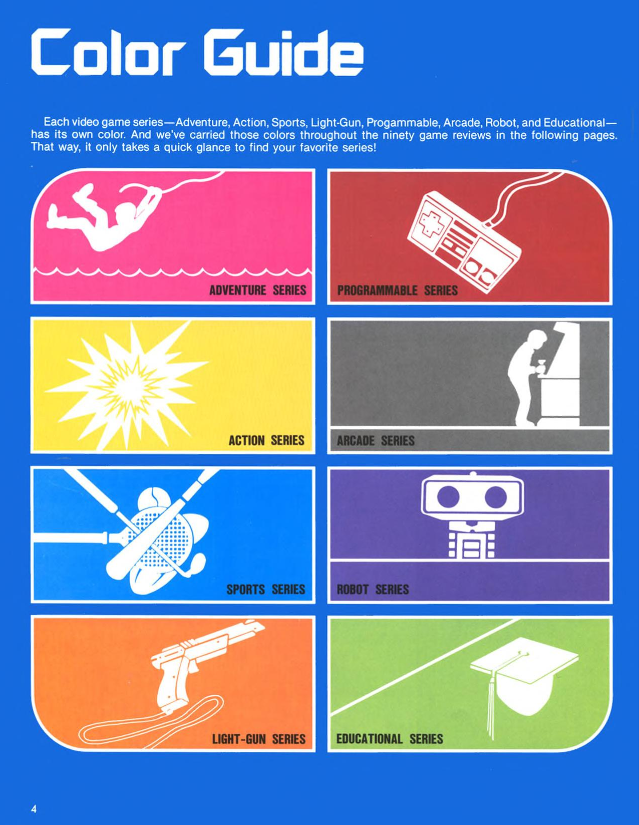
These genres match the genre emblems found in the "Black Box" series of game packages. You can see "Action Series" prominently displayed on this copy of Super Mario Bros:
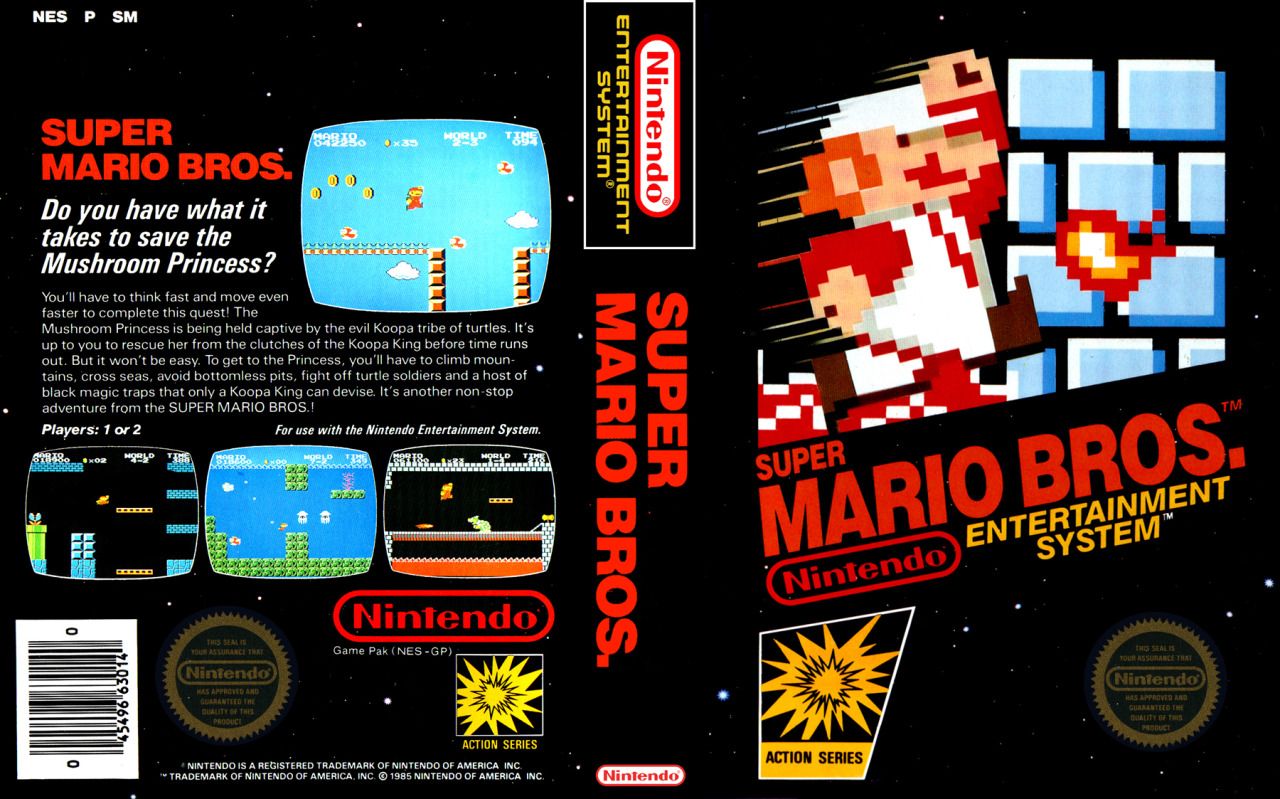
As far as I can tell, exactly 30 games were released under this packaging format. Future releases took on more illustrative packaging art, and dropped the explicit genre callouts:

Nevertheless, between the Player's guide and the Black Box series we have some decent information on how Nintendo of America was classifying their games in this period:
Genre | Notable Titles |
|---|---|
Action | Balloon Fight, Clu Clu Land, Ice Climber, Kung Fu, Pinball, Super Mario. Bros, Urban Champion |
Adventure | Zelda (1 & 2), Metroid, Castlevania, Kid Icarus |
Arcade | Donkey Kong (1-3), Mario Bros., Popeye |
Sports | 10-Yard Fight, Baseball, Golf, Pro Wrestling, Slalom, Soccer, Tennis, Volleyball |
Education | Donkey Kong Jr. Math |
Light Gun | Duck Hunt, Gumshoe, Hogan's Alley, Wild Gunman |
Programmable | Excitebike, Mach Rider, Wrecking Crew |
Robot | Gyromite, Stack-up |
And here's the 90 titles in the Player's Guide:
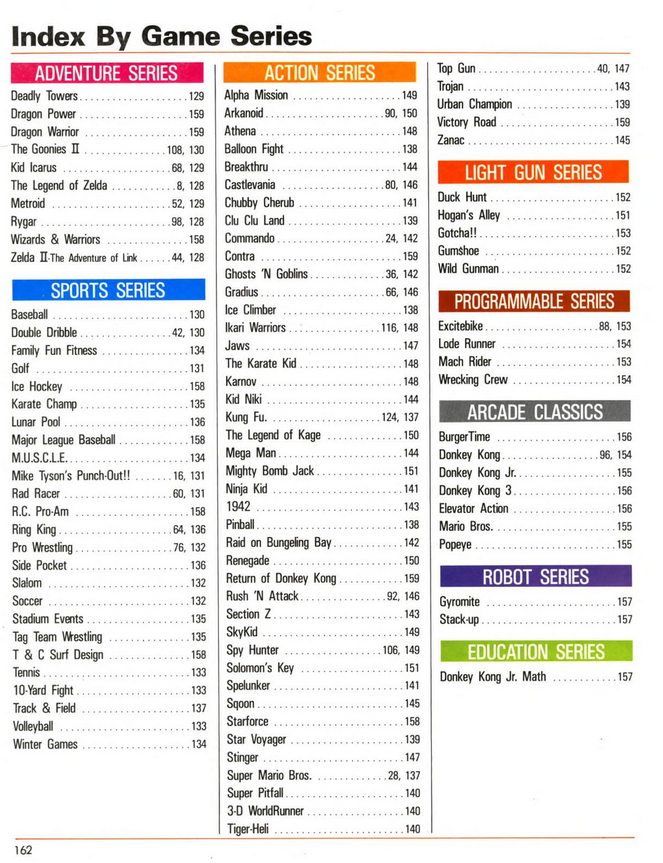
Action, Adventure, Arcade, and Sports are familiar to modern eyes, and even Education isn't so far out – but genres like Light Gun, Programmable, and Robot are notably dated.
Light Gun games straightforwardly make use of the Nintendo Zapper.
Programmable games seem to feature some sort of customizability – such as Excite Bike's track editor
Robot games (both of them) are compatible with the R.O.B.
Nintendo is famously credited with resurrecting the home video game market after the notorious Atari Crash, and the package design and presentation of their first 30 games seems to tell a story of earnest transparency meant to win back trust – instead of fanciful illustrations that look nothing like the game as in the Atari era, you have simulated pixel art: what you see is what you get. The genre emblems and screenshots might have been an important part of their customer and dealer education – particular when highlighting unique and interesting features such as the Light Gun and the R.O.B.
As Nintendo found their footing and gained confidence, the overly literal box illustrations and genre callouts seem to have disappeared.
But let's return to the genres that have persisted to the modern day – Action, Adventure, Arcade, and Sports.
This genre still lives with us today, but as actual arcade machines fade further into obscurity so does its contemporary meaning grow ever more muddled. But back in the NES era, this genre had a very clear and objective meaning: "This is a conversion/port of a coin-op game". This genre signified nothing about the gameplay style, mechanics, or tropes, merely that the original version was played on a literal Arcade cabinet.
Another very straightforward genre, which unlike Arcade retains this straightforwardness today. It's a game about sports, the end.
Any simple and straightforward Action-y title that wasn't Sports or Arcade (or qualified under one of the special categories like Light Gun, etc), was Action. This genre persists today. It's a very simple term, although incredibly broad.
This is the most subjective of Nintendo's early genres. But from the very start, Zelda and Metroid were classified as Adventure games, which suggests that having a large, connected, non-linear world was a key feature. Castlevania and Kid Icarus are classified as Adventure too, even though each of those featured a more traditional linear level progression. Perhaps the stronger emphasis on theme, story, and set dressing of those games helped to tip the scales.
(As an aside, genre nerds might see this as evidence for Metroidvania being a sub-genre of Adventure – though keep in mind this iteration of Castlevania was well before Symphony of the Night).
I'd also like to note the icon for Adventure: a guy swinging on a vine, suspended over a pool of water:
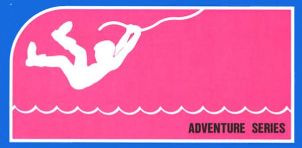
I absolutely refuse to believe this isn't a direct reference to Pitfall for the Atari 2600:
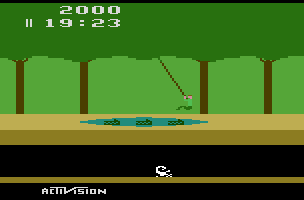
Notably missing from the NES's genre classification scheme are classics like RPG and Puzzle, especially considering how many of those were released on the NES. Of course, old issues of Nintendo Power will describe titles like Final Fantasy and Dr. Mario with the word "RPG" or "Puzzle game" in the middle of a long paragraph, but I haven't found any formal genre markers for those terms in Nintendo's own consumer-facing marketing copy or packaging.
The Box art for Dragon Warrior does call itself a "New Role-Playing Epic!":
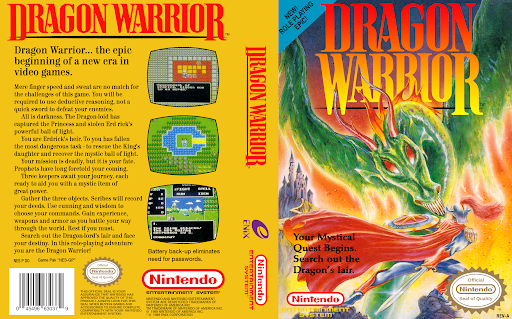
And the back of the box calls it a "Role-playing adventure." However, this designation was likely made by Enix, not Nintendo.
Final Fantasy has neither the word "RPG" nor "Role-Playing" on the front of the box. The closest to a genre term is the word "Adventure" in the tagline: "Enter a whole new realm of challenge and adventure," though I'd hardly take that as an intentional genre designation, formal or otherwise. The back of the box describes the game as a "massive role-playing adventure."
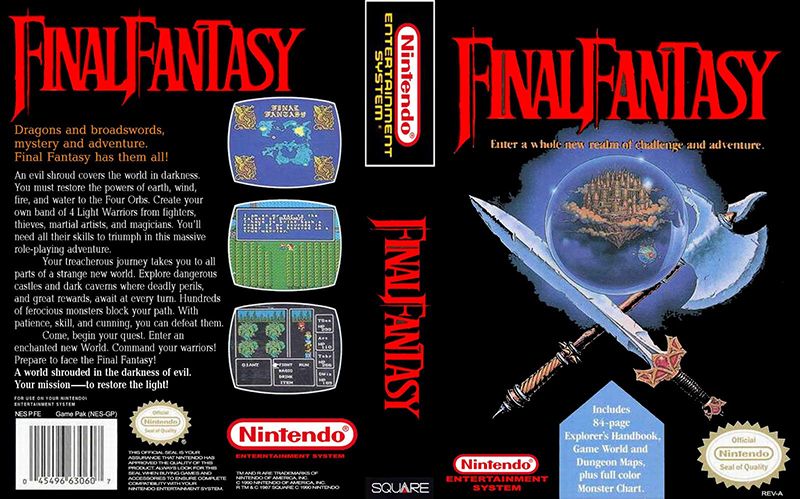
This is consistent with the overall pattern of no standardized formal genre designations on the packaging; however now and then key genre terms may appear in descriptive text or as informal marketing callouts.
If you have a careful eye, you'll notice that Dragon Warrior is formally classified by Nintendo as part of the Adventure series:
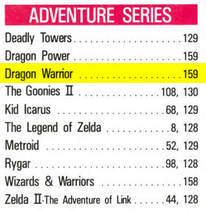
Strategy and Simulation are not here, though this is understandable given the simplicity of the NES platform. Still, there were several games that would have fit under these descriptors.
Racing is noticeably missing too. The Black Box series only had a few games that could be considered Racing – Mach Rider and Excitebike are clear candidates, but they feature editable courses and were thus classified under Programmable instead. Slalom could also be considered Racing but it's categorized under Sports, which isn't surprising – Sports & Racing tend to be closely associated, much like Action & Adventure.
Moving on the Game Boy, we have less to go on. The US packaging featured no formal genre markers that I've been able to find:
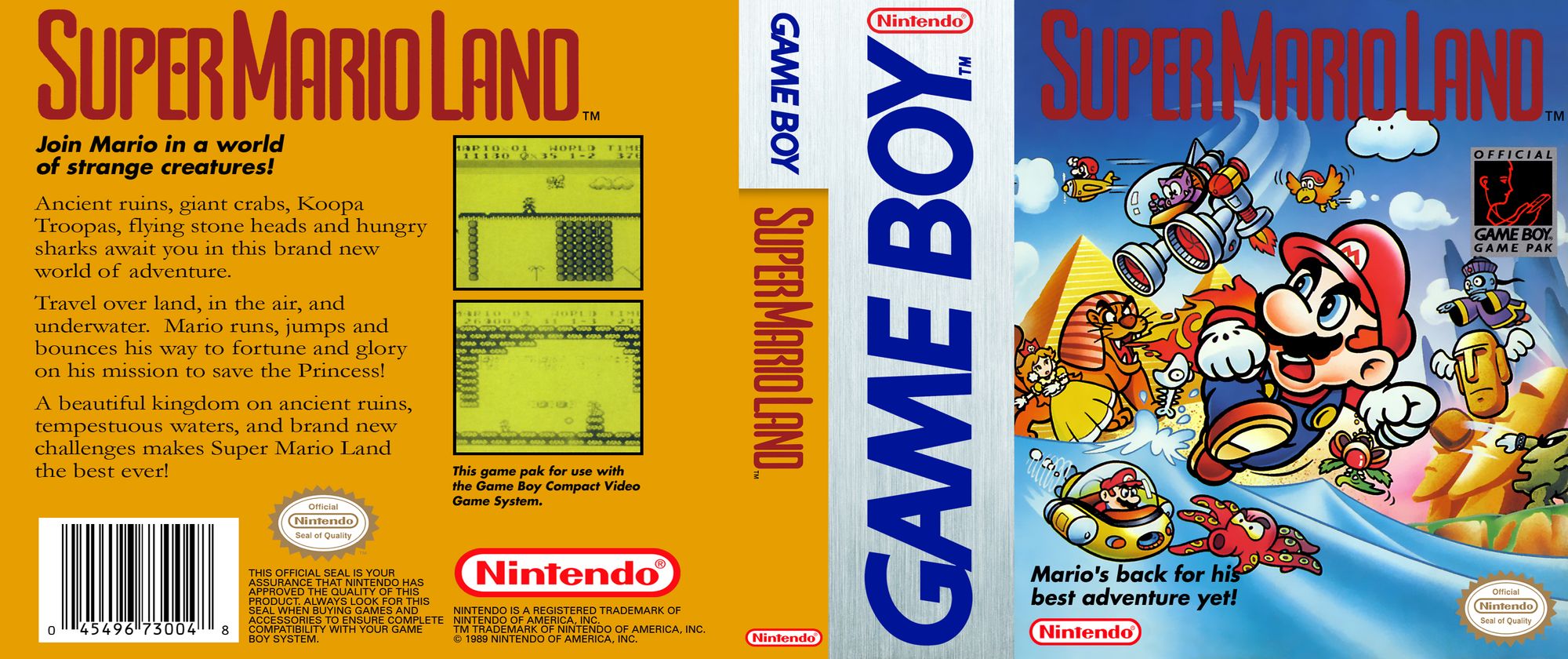
Fortunately, we do have the Game Boy Player's Guide from 1991:
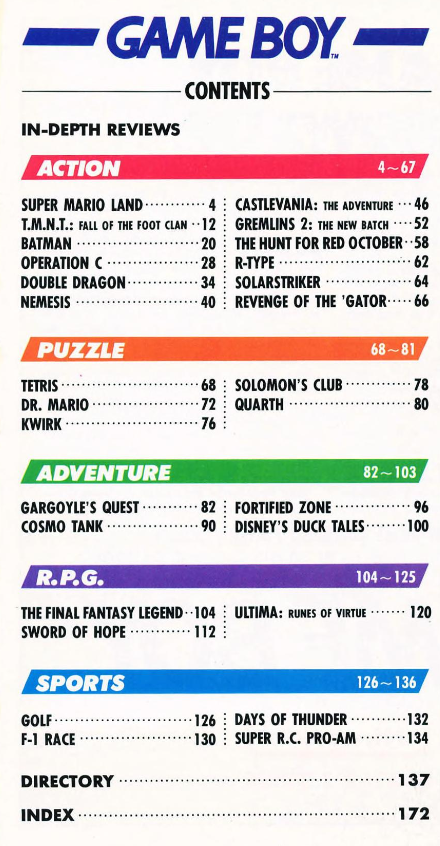
We see Action, Adventure, and Sports make their return, and now we finally see Puzzle and RPG. Arcade as well as the NES's specialty genres are gone, and Simulation and Strategy have yet to appear–though their absence makes sense given this is the original 4-color gameboy we're talking about.
Action continues to be the dominant genre, especially now that Arcade is gone. Interestingly enough, the game boy version of Castlevania is considered an Action game and not an Adventure game, though it is amusingly subtitled "the Adventure".
On the other hand, Duck Tales is considered an Adventure game, perhaps owing to its strong theme & setting (for a Gameboy game), and its nonlinear stage select system. Though admittedly, Mega Man has much the same structure and I'm 90% sure the Gameboy Mega Man titles would have been considered Action games.
Gargoyle's Quest, Cosmo Tank, and Fortified Zone are more clear-cut, however – each of them features a lot more exploration, dialogue and non-linear level design.
SNES packaging, like the Gameboy's, doesn't seem to feature any formal genre markers:
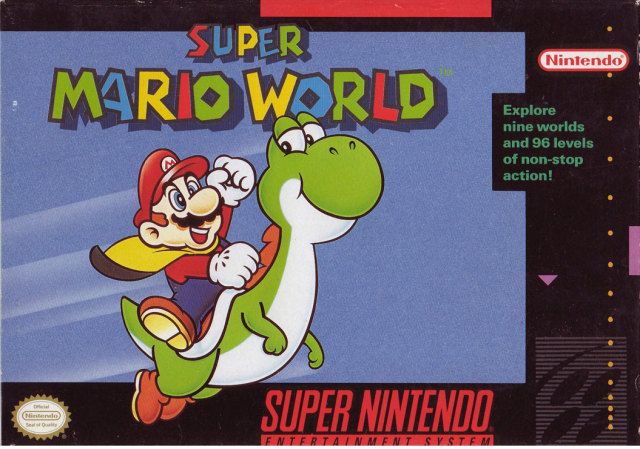
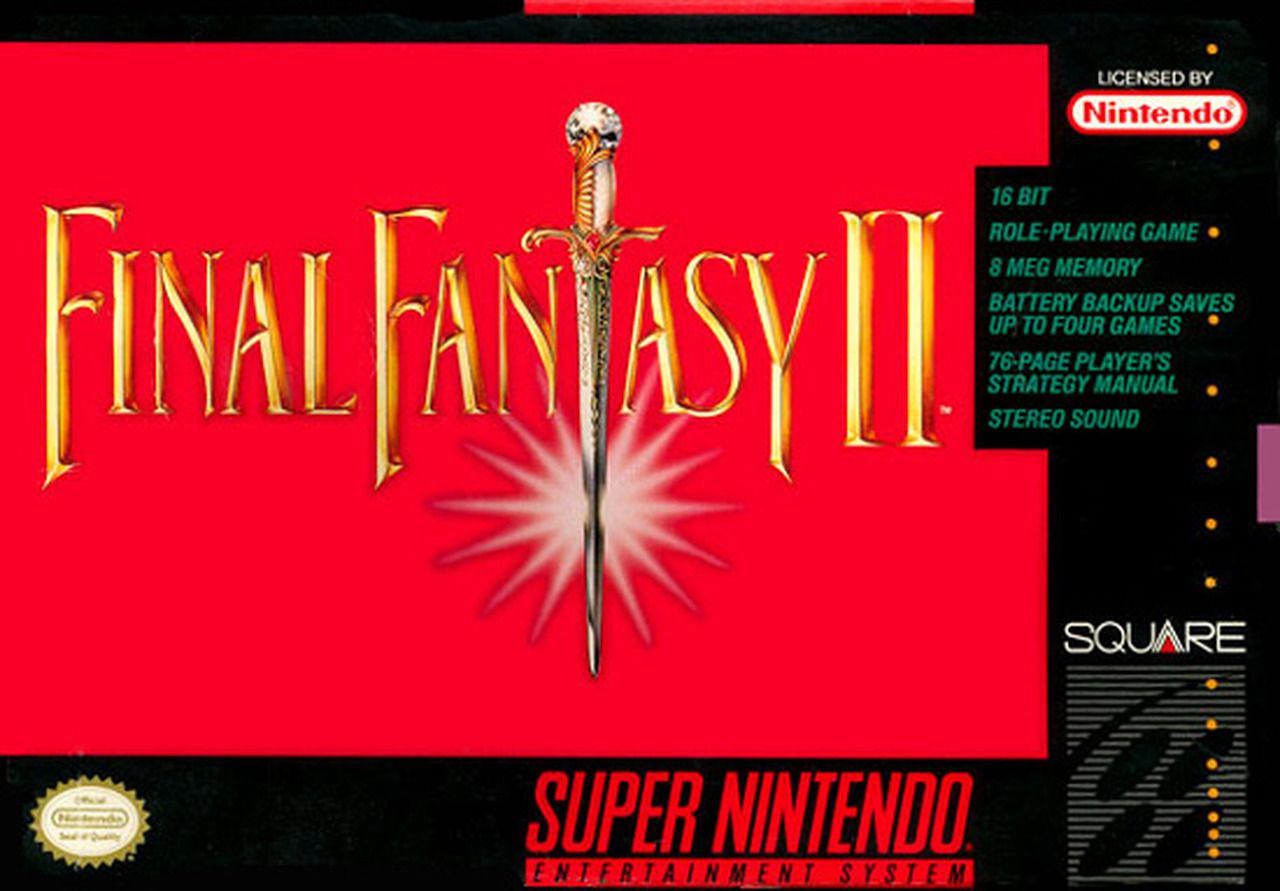
...or does it?
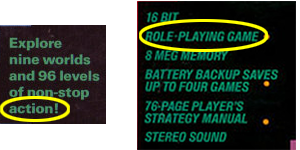
It seems pretty inconsistent. Chrono Trigger has nothing:
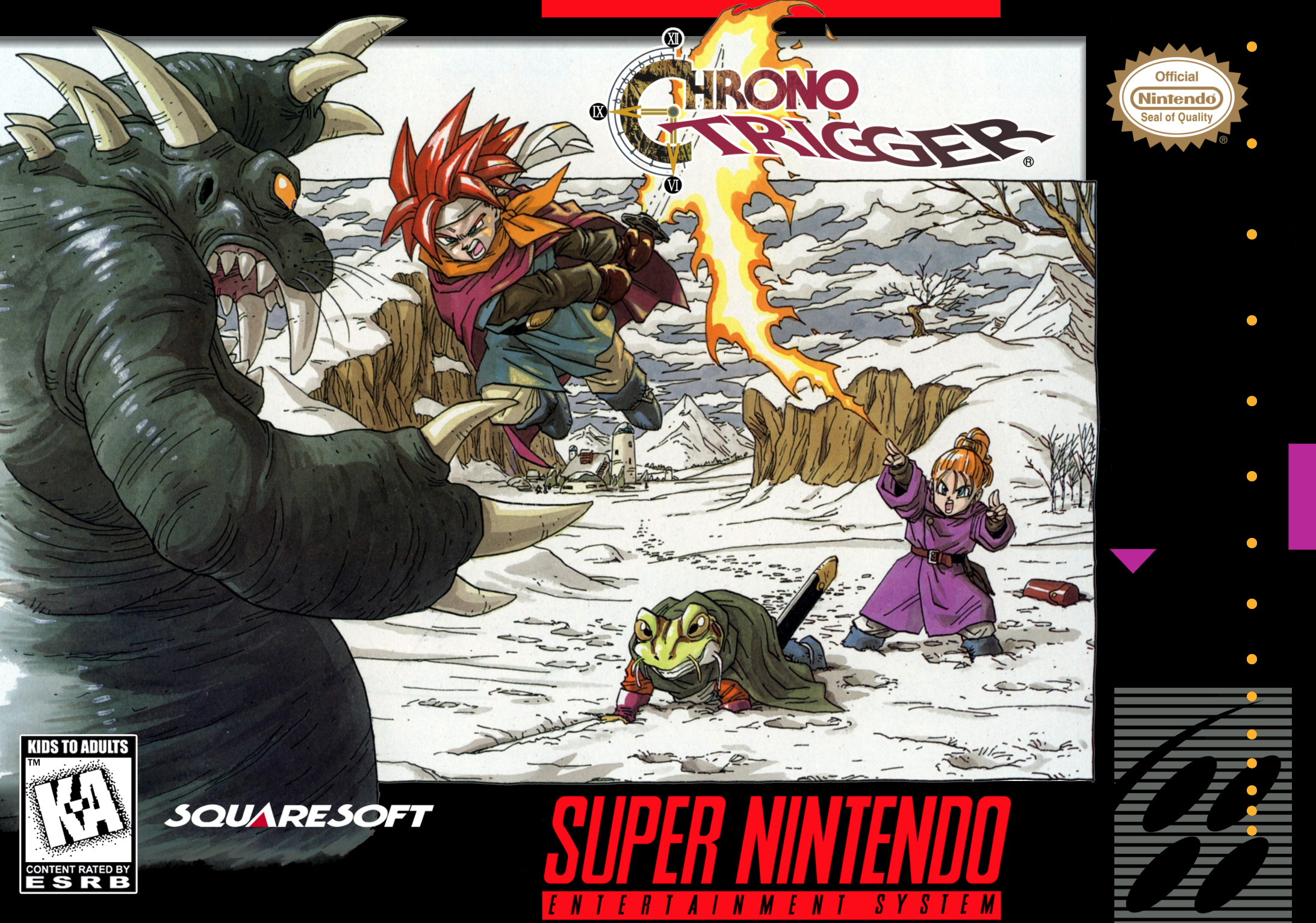
Secret of Mana has a bullet point that says "First Game in a new Action/Adventure series":
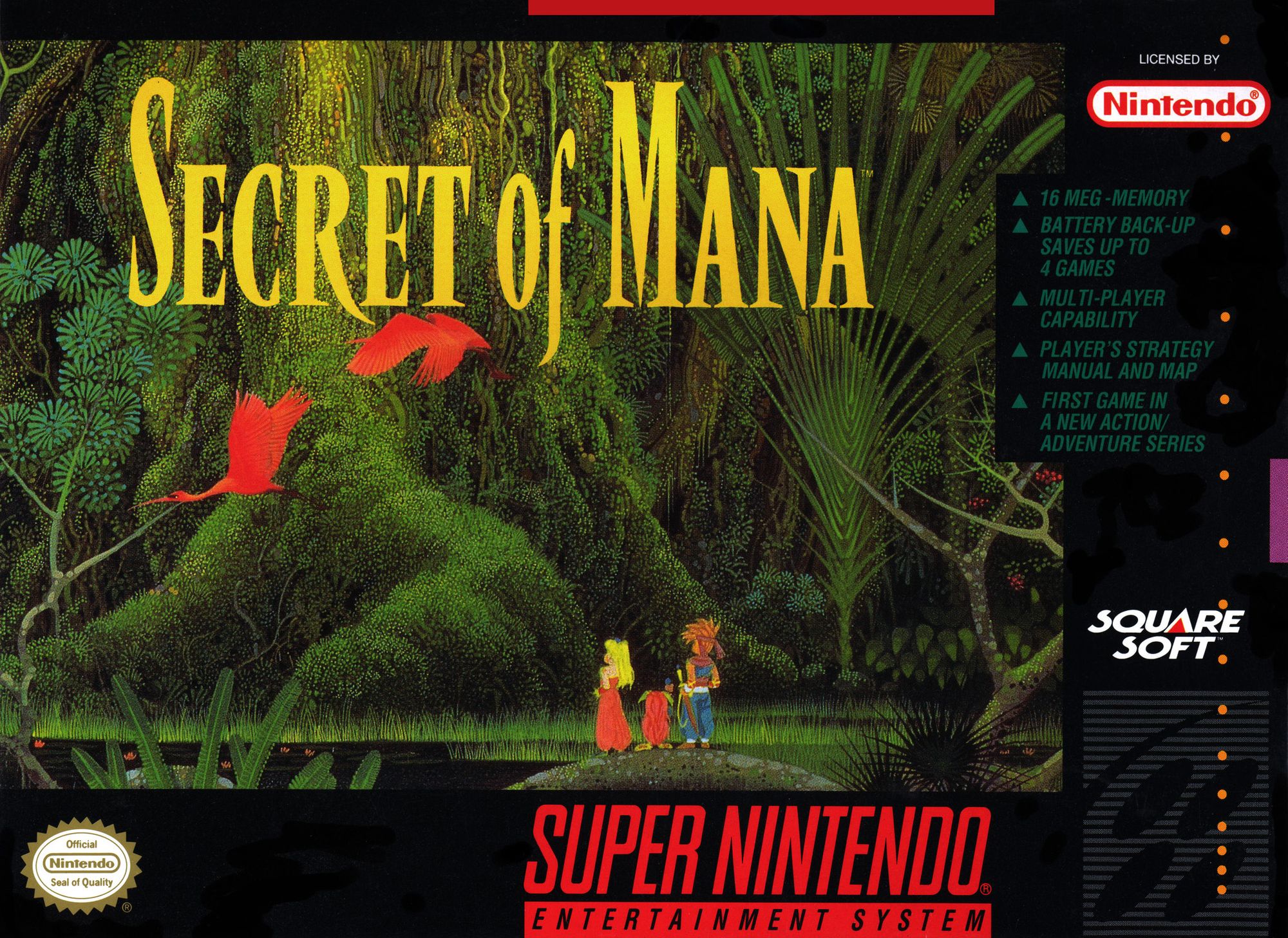
Which seems to indicate that this is more generic marketing copy that happens to use a genre term now and then rather than a formal genre marker system imposed by the platform itself.
So let's go back to our trusty source – the Super NES Player's Guide:
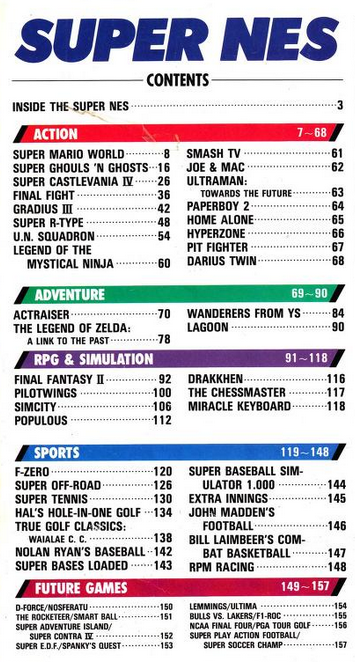
Action and Sports are, as usual, the biggest genres.
The Castlevania series has gone back to being Action. The rest of the Action and Adventure titles seem to make sense, but if you really wanted you could make a case for Legend of the Mystical Ninja being an Adventure game. This is all just further evidence that the line between Action and Adventure has been blurry from the beginning.
But a few keystones remain – The Legend of Zelda: A Link to the Past is an Adventure game, as usual. So are the nonlinear side-scrollers Wanderers from Ys and Actraiser, as well as the zeldalike Lagoon. Some of these could honestly be considered "RPGs" under the modern definition, but they all feature real-time combat, which seems to be a key differentiator here. (But Drakkhen, an "RPG" has real-time combat too! Although it's way more stats-and-menu heavy...)
RPG is tucked together with "Simulation" in this menu, but that might just be because this player's guide only chose to surface two of them.
This is a new genre for Nintendo, and actually has more titles represented in this player's guide than RPG – even on the SNES, this genre was always more than just SimCity! We see Populous (a further sign of growing cross-pollination between PC's and consoles), as well as Pilotwings (a classic flight simulator and launch title), a chess game, and the Miracle piano/keyboard educational program (which was also available on the NES). So it seems that Simulation is also consolidating the Programmable and Education genres from the NES.
Puzzle is gone, and Strategy has yet to be seen, even though there were plenty of both kinds of games on the SNES.
A couple of key things stand out from this exercise:
It's fascinating how little game genres were formally used in consumer facing materials in the early Nintendo era. Where they were used at all, it was sparing and somewhat inconsistent, limited to an early run of NES packages and a single promotional player's guide for each platform that highlighted a small selection of games.
Admittedly I hardly conducted an exhaustive search, there could well be a bunch of material I've missed. That said, Nintendo Power magazine and the game packages themselves were two of the strongest ways Nintendo had to directly reach out to customers. Perhaps advertisements and other marketing materials had more to say on the subject, but it doesn't seem like a natural place to find a formal genre classification system.
The one place I might expect to see one is in the materials that Nintendo sent to their retail partners. I haven't been able to surface any of those dealer catalogs, but if I can get my hands on some I'll update this article with my findings.
All in all, the limited use of genres makes a lot of sense for this era. Games were still primarily thought of as being for kids, and the genres themselves had barely been established. Most importantly, the total number of games was still quite small, so sorting them neatly into categories might simply not have been necessary yet.
These four genres seem to have been there from the beginning, and persist to this day.
Arcade faded from prominence on Nintendo platforms as the market shifted from coin-op arcades to home consoles as the primary mode of play.
Action and Adventure have been favorite ways of describing games from the beginning. On Nintendo platforms, Super Mario was always the prototypical Action series and Zelda the prototypical Adventure series, with plenty of fuzziness at the boundaries of the two terms.
Sports has always been there, and always been pretty big. Nintendo never saw fit to break out Racing as its own genre, or to pair it alongside Sports as we sometimes see today ("Sports & Racing").
These genres found their way onto Nintendo platforms later on, sometimes popping in and off the radar. This makes sense as these tend to be more complex games, often slow-paced, text-heavy, and many were turn-based rather than real-time (the latter being a key staple of Action and Adventure titles).
Puzzle found huge success on the Gameboy with Tetris so it makes sense for it to make its debut there, and it makes sense that we don't see Simulation as its own genre until the SNES, given that genre's inherent complexity.
The omission of RPG from the NES is probably just because there didn't happen to be any RPGs in the first 30 Black Box games. I had initially guessed that early RPGs on the NES were formally classified under Adventure, with the RPG genre emerging as a distinct term later on, and this was confirmed by Dragon Warrior's listing in the NES Player's Guide.
This just barely scratches the surface. I didn't look into the Japanese side of Nintendo at all, nor did I look into the early days of the PC, Atari, SEGA, Sony, Commodore, Amiga, etc. All of that is ripe for analysis but I think it makes sense to just zoom into one small slice at a time lest I get overwhelmed.
If I do another of these, we'll talk about the Sega Master's Sysem, Game Gear, and Megadrive/Genesis next.
Read more about:
Featured BlogsYou May Also Like